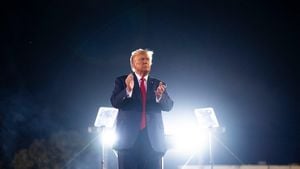New York City is taking to the skies with its latest initiative to leverage technology for public safety. On November 13, 2024, Mayor Eric Adams and Interim Police Commissioner Thomas Donlon announced the launch of the NYPD's "Drone as First Responder" (DFR) program, revolutionizing how the city's police force responds to emergencies.
This innovative program is set to deploy drones across three boroughs, focusing on five NYPD precincts: the Central Park Precinct, the 67th, 71st, and 75th Precincts in Brooklyn, and the 48th Precinct in the Bronx. Each location will house two state-of-the-art drones, equipped to react swiftly to various emergency scenarios, from searches for missing persons to gunshot alerts from the ShotSpotter system.
The DFR program marks the NYPD as the first police department nationwide to receive permission from the Federal Aviation Administration (FAA) to fly drones remotely from a single centralized location, known as 1 Police Plaza. This allows for precise responses to emergencies at designated longitude and latitude coordinates, increasing the overall efficiency and effectiveness of the department's operations.
At the heart of the program is the ability to quickly gather situational awareness. NYPD drones are equipped with high-definition video and audio capabilities, which feed real-time data back to officers' smartphones on the ground. Officer Craig Vitale, one of the licensed drone pilots, expressed the potential benefits, saying, "I've been on the ground, and if we had this [drone technology] available, how much easier and safer it could have been."
According to Deputy Mayor for Public Safety Chauncey Parker, the program is not just about speed; it enhances the capacity to respond more effectively. "When New Yorkers need help, our first responders are always there as quickly as possible... This program adds a powerful tool to our toolkit," Parker stated. The drones are already poised to execute missions during dire situations when every second counts.
Since 2018, the NYPD has operated drones for various tasks, including search and rescue, infrastructure inspections, and evidence collection. Last year alone, the department reported flying drones on over 4,000 assignments, demonstrating their increasing reliance and proficiency with this technology. Under the new DFR initiative, the department's aim is to build on this foundation and become a national benchmark for integrating drones within law enforcement practices.
The NYPD's growing fleet currently comprises 100 drones supported by more than 110 FAA-certified operators. Each DFR mission is monitored by legal advisors to meet necessary compliance regulations and accountability standards. Such measures are part of the NYPD's commitment to transparency, with all recorded footage automatically deleted after 30 days, except when it serves as evidence for investigations.
The DFR program is not only transformative for policing but could potentially reshape public safety's future. The capability of sending drones to locations faster than patrol vehicles opens new avenues for controlling situations before they escalate. Commissioner Donlon described the program as being "part of our crime-fighting apparatus, and it is truly a game-changer."
There are also plans for the drones to expand beyond emergency response. Soon, they could be used to deliver medical supplies such as automated external defibrillators and naloxone to those experiencing health crises. The versatility of the drones allows them to assess hazardous environments without exposing officers to immediate danger.
Experts agree on the significant cost advantages drones offer. Compared to traditional helicopter operations, they are less resource-intensive and provide extensive aerial surveillance without overwhelming police budgets. This enables the NYPD to allocate helicopter resources to other urgent missions, ensuring comprehensive coverage across New York City.
Mayor Adams highlighted the broader vision behind the DFR program, stating, "New York City is flying its way to the future as we keep New Yorkers safe. While the potential for drones is just taking off, we are already seeing the benefits of more precise policing strategies."
To date, the incorporation of drone technology has proven successful, with drones dispatched to various emergency calls, generating thousands of real-time insights for on-the-ground officers. The department anticipates building on this momentum and incorporating additional technological enhancements as they strive to create a safer urban environment for all residents.
The implementation of the DFR program reflects the NYPD's commitment to modernizing its practices amid increasing safety challenges. With drones aloft across major city areas, officials remain hopeful this move will help reduce crime rates and quickly address emergencies, marking the dawn of high-tech policing within New York.
Overall, as cities worldwide contend with crime and public safety concerns, the NYPD's innovative use of drone technology might serve as both inspiration and evidence of what advanced policing can achieve, taking urban law enforcement to new heights.



